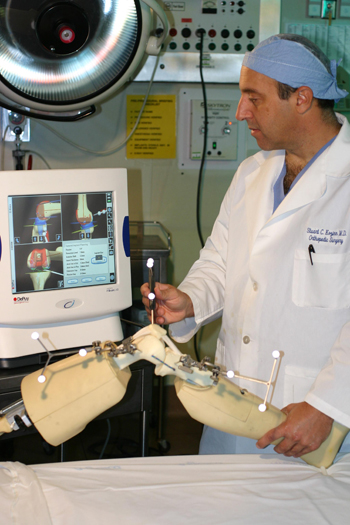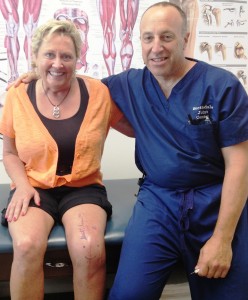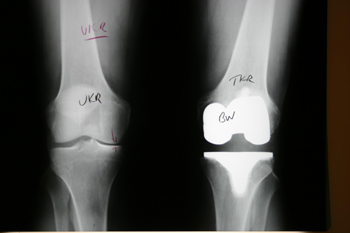Newer technology keeps people active longer and are predicted to improve the lifespan of modern joint replacements to 30 years and beyond. It is now possible to do these operations on younger, more active patients, and feel good about the long term prospects.
 Active people are living longer and are able to enjoy sports and physical activities well after their “fifties.” Orthopedic surgeons are enjoying increased success at replacing human joints with better and longer lasting technologies. Space age bio-materials and computer assisted improvements are now helping patients with joint pains and arthritis live a better and more active life. Most people over 50 know a friend or relative who has had a total hip or total knee replacement. Newer technologies are predicted to improve the lifespan of modern joint replacements to 30 years and beyond. It is now possible to do these operations on younger, more active patients, and feel good about the long term prospects. Previous recommendations to avoid certain sports and labor are changing as we see patients with joint replacements doing better enjoying activities such as tennis, golf, and skiing.
Active people are living longer and are able to enjoy sports and physical activities well after their “fifties.” Orthopedic surgeons are enjoying increased success at replacing human joints with better and longer lasting technologies. Space age bio-materials and computer assisted improvements are now helping patients with joint pains and arthritis live a better and more active life. Most people over 50 know a friend or relative who has had a total hip or total knee replacement. Newer technologies are predicted to improve the lifespan of modern joint replacements to 30 years and beyond. It is now possible to do these operations on younger, more active patients, and feel good about the long term prospects. Previous recommendations to avoid certain sports and labor are changing as we see patients with joint replacements doing better enjoying activities such as tennis, golf, and skiing.
One new technique in knee replacement involves the use of a computerized navigation system to plan and more accurately execute the positioning of the implants. Much like the “GPS” system in your new car, the total knee computer calculates a mathematical image of a patient’s leg after the surgeon inputs a number of specific anatomical data points. The computer screen shows an image of the knee than can move in real time. It also calculates the best position and angle to make the bone cuts so that the resulting knee replacement will be well balanced and aligned.
Orthopedic surgeons and bio-engineers believe the key to longer lasting knee implants is near “perfect” alignment to minimize wear, much like the need to maximize the alignment of the tires on your car. Presently the alignment data is transmitted form the leg to the computer by an infa-red sensor which “reads” the position of six fixed points marked on the limb using small removable pins. In the future, the pins will be replaced with permanent electrode capsules, much like implantable chips that can be placed in pets to locate them if they are lost. The chips will transmit position data to the computer, and when combined with future “smart implants” will let the surgeon know if the implants are functioning normally. Patients with chip-imbedded implants will get a check up by placing the leg under the “GPS” sensors, so the surgeon can “see” beneath the skin on his computer screen as the patient moves his or her knee. New techniques in anesthesia have decreased the pain associated with knee replacement surgery. A femoral nerve block can be placed at the patients discretion in the pre-operative area which greatly decreases the immediate pain upon waking up, yet still allows early ambulation. We like spinal or regional anesthesia, because it is safer an results in much less pain post operatively. Knee implant designs are also improving, which will significantly increase the life span of total knees. I often use a mobile bearing highly cross-linked polyethylene insert called a “rotating platform” in younger and more active patients. This allows a few degrees of twisting motion in the knees during sports such as tennis and golf, and acts as an additional shock absorber over the long term. I think it results in a better and more longer lasting knee.

 Partial knee replacements are done in patients with an arthritis limited to one side of the knee. These are done through a very small incision that does not violate the quadriceps muscle, and recovery is very rapid. Patients with partial knees often go home after a one night stay in the hospital, and in most cases do not need formal physical therapy to regain their knee motion. The partial knee procedure is also less stressful on elderly patients and patients with significant heart or vascular disease. The bottom line is that younger patients are now better candidates for joint replacement surgery than in the past. More patients are choosing a joint replacement to get on with the most active and productive times of their life.
Partial knee replacements are done in patients with an arthritis limited to one side of the knee. These are done through a very small incision that does not violate the quadriceps muscle, and recovery is very rapid. Patients with partial knees often go home after a one night stay in the hospital, and in most cases do not need formal physical therapy to regain their knee motion. The partial knee procedure is also less stressful on elderly patients and patients with significant heart or vascular disease. The bottom line is that younger patients are now better candidates for joint replacement surgery than in the past. More patients are choosing a joint replacement to get on with the most active and productive times of their life.
